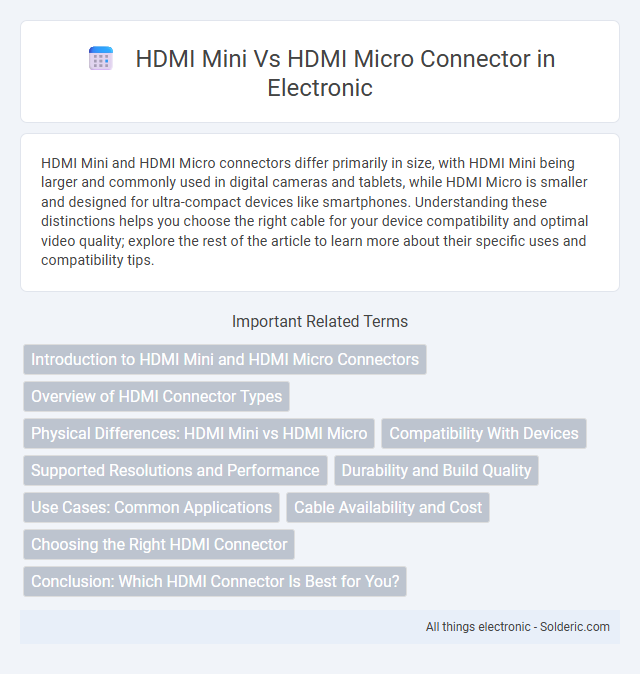HDMI Mini and HDMI Micro connectors differ primarily in size, with HDMI Mini being larger and commonly used in digital cameras and tablets, while HDMI Micro is smaller and designed for ultra-compact devices like smartphones. Understanding these distinctions helps you choose the right cable for your device compatibility and optimal video quality; explore the rest of the article to learn more about their specific uses and compatibility tips.
Comparison Table
| Feature | HDMI Mini | HDMI Micro |
|---|---|---|
| Connector Size | 10.42 mm x 2.42 mm | 6.4 mm x 2.8 mm |
| Common Usage | Tablets, DSLR cameras, Camcorders | Smartphones, small portable devices |
| Pin Count | 19 pins | 19 pins |
| Durability | Moderate, suitable for occasional connection | Higher, designed for frequent use |
| HDMI Version Support | Up to HDMI 2.0 and beyond | Up to HDMI 2.0 and beyond |
| Compatibility | Requires adapter for standard HDMI | Requires adapter for standard HDMI |
| Typical Cable Length | Up to 10 meters | Up to 10 meters |
Introduction to HDMI Mini and HDMI Micro Connectors
HDMI Mini and HDMI Micro connectors serve as compact variants of standard HDMI designed for portable devices, with the Mini HDMI (Type C) typically used in digital cameras and camcorders, and the Micro HDMI (Type D) found in smartphones and tablets. Both connectors support high-definition video and audio transmission, maintaining HDMI's core functionality while optimizing size for space-constrained gadgets. The Mini HDMI is slightly larger than the Micro HDMI, offering a balance between durability and compactness, whereas the Micro HDMI prioritizes ultra-miniaturization for slim-profile devices.
Overview of HDMI Connector Types
HDMI Mini and HDMI Micro connectors are both smaller derivatives of the standard HDMI Type A connector, designed for compact devices such as cameras, tablets, and smartphones. The HDMI Mini (Type C) features 19 pins and measures approximately 10.42 mm x 2.42 mm, offering a balance between size and durability, while the HDMI Micro (Type D) is even smaller at 5.83 mm x 2.20 mm with 19 pins, suitable for ultracompact devices. Both connectors support full HD video and audio but differ primarily in their physical dimensions to accommodate various device designs.
Physical Differences: HDMI Mini vs HDMI Micro
HDMI Mini connectors are larger, measuring approximately 10.5 mm wide, designed primarily for portable devices like cameras and tablets, while HDMI Micro connectors are smaller, around 6.4 mm wide, suited for even more compact devices such as smartphones. The physical build of HDMI Micro is thinner and more delicate, necessitating careful handling to avoid damage. Understanding these size distinctions helps ensure you select the appropriate HDMI interface for your device's physical constraints.
Compatibility With Devices
HDMI Mini connectors are commonly found on older digital cameras, camcorders, and some tablets, providing compatibility with a wide range of multimedia devices. HDMI Micro connectors are designed for smaller portable devices like smartphones and ultra-compact cameras, offering a more space-efficient connection. Understanding the device requirements helps you choose the right HDMI connector for seamless multimedia connectivity.
Supported Resolutions and Performance
HDMI Mini connectors commonly support resolutions up to 1080p and 4K at 30Hz, suitable for most tablets and cameras, while HDMI Micro connectors often handle similar resolutions but are optimized for smaller devices like smartphones with slightly lower power consumption. Both connectors maintain HDMI 1.4 or higher standards, enabling HDCP compliance and supporting 3D video and audio return channel (ARC) features. Performance differences mainly stem from device compatibility and physical size constraints rather than disparity in video or audio transmission capabilities.
Durability and Build Quality
HDMI Mini connectors typically offer robust durability with reinforced casings designed for frequent plugging and unplugging, making them well-suited for portable devices like digital cameras and camcorders. HDMI Micro connectors, while smaller and designed for ultra-compact devices, often have more delicate pins and a slimmer build, which can be more susceptible to wear and damage over time. Both connectors use high-quality materials, but the Mini HDMI's slightly larger form factor generally translates to enhanced build quality and longevity.
Use Cases: Common Applications
HDMI Mini connectors commonly appear in portable electronics like digital cameras, camcorders, and some tablets, providing high-quality audio and video transmission in a compact form. HDMI Micro connectors are primarily used in smaller devices such as smartphones, action cameras, and ultra-compact tablets, supporting similar high-definition multimedia capabilities but designed for even tighter physical constraints. Both connectors facilitate seamless connection to HDTVs, monitors, and projectors, enabling portable devices to display content with exceptional clarity and sound quality.
Cable Availability and Cost
HDMI Mini connectors offer broader cable availability due to their use in varied devices like cameras and tablets, making them generally more accessible and affordable. HDMI Micro cables are less common, leading to higher prices and limited retail options. Budget-conscious consumers often find HDMI Mini cables more cost-effective and easier to source.
Choosing the Right HDMI Connector
Choosing the right HDMI connector depends on device compatibility and application needs, with HDMI Mini primarily used in portable cameras and tablets, while HDMI Micro is common in smartphones and small devices. Your decision should consider cable durability and connector size, as HDMI Micro offers a more compact solution but may be less robust compared to HDMI Mini. Ensuring the connector matches your device's port type guarantees optimal video and audio transmission without compatibility issues.
Conclusion: Which HDMI Connector Is Best for You?
HDMI Mini connectors offer a balance between size and compatibility, commonly used in cameras and tablets, while HDMI Micro connectors provide an even smaller form factor, ideal for ultra-compact devices like smartphones and action cams. Choosing the best HDMI connector depends on your device's physical dimensions and port availability, with HDMI Mini suited for slightly larger portable electronics and HDMI Micro for space-constrained gadgets. Assess your device requirements and ensure cable compatibility to select the most efficient HDMI connector for optimal video and audio transmission.
HDMI Mini vs HDMI Micro connector Infographic

 solderic.com
solderic.com